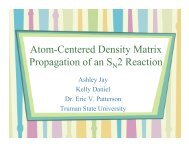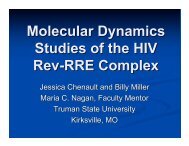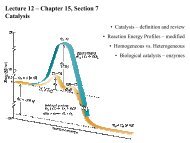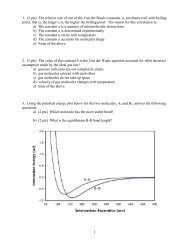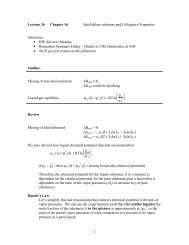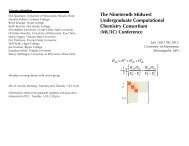R T / Θvib - Chem.hope.edu
R T / Θvib - Chem.hope.edu
R T / Θvib - Chem.hope.edu
You also want an ePaper? Increase the reach of your titles
YUMPU automatically turns print PDFs into web optimized ePapers that Google loves.
C v,vib (HI or HCl, infinite temp) = 8.31 J K -1 mol -1 (the maximum contribution tothe heat capacity for each vibrational mode is R) High temperature limit isT > Θ(indicate on figure)We can see here that the vibrational contribution to the heat capacity depends on thetemperature and bond strength of the molecule (frequencies of its vibrationalmodes). This contribution is the primary reason why heat capacity does, ingeneral, depend on temperature for polyatomic molecules.Finally for electronic the energy spacings are huge, so the ground state is the only one thatcontributes, even at very high temperatures.=−βεjq g eelecHCl: 298 Kq HCl∑levelsjelec= 1 (energy of lowest excited state is much higher than kT at 298 K)For most atoms and molecules, the electronic degree of freedom does not significantlycontribute to the average energy or to the heat capacity = 0 or U elec = 0 and C v,elec = 0SummaryOK, so let’s go back and summarize. For HCl the partition function is (ask for values?)huge for translational (10 29 )a handful for rotational (20)just over 1 for vibrational (1.0000007)and exactly 1 for electronic (1)We can now sum up the total heat capacity for a molecule like HCl at 298 KC v,298 K = C v,trans + C v,rot + C v,vib + C v,elec = 3/2 R + R + C v,vib + C v,elec= 12.46 + 8.31 + 0.0012 + 0 J K -1 mol -1 = 20.78 J K -1 mol -1The experimental value at 298 K is 20.81 J K -1 mol -1 .2



